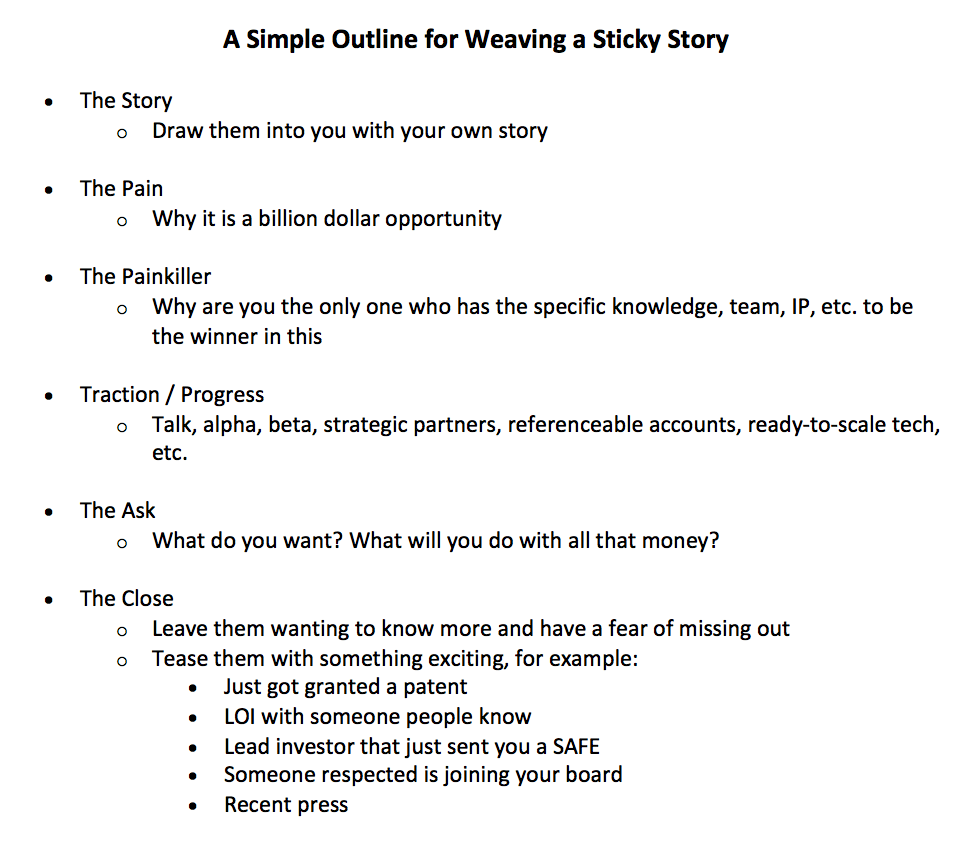Craft a sticky story of your company’s journey.
Last week I had a Monday morning meeting with the founder of a pre-seed, self-funded company. We had been collaborating for almost a year and he told me that they had their first pitch competition in three days. He wanted to do a review of their pitch with me.
After a quick run through his pitch, I gave him my brutally honest take on it: “None of it was usable”
The deck would have been OK for an investor sit down, but it was not appropriate for a three minute pitch in front of an audience where the goal is not to attract investors but rather to win a competition – or at least to peak interest and to be memorable. After all, win or not, you want them talking about you afterwards. A totally different frame of mind is necessary in the prep and the delivery for an event like this. You do not need to be a Ted Talk master, but you do need to tell an authentic story people will remember and connect with.
Unfortunately, they had already submitted the deck and could not make changes. I pondered for a moment. The deck had one good slide so I advised them to just focus on that one slide and ignore the rest. As scary as it sounded, a good story focusing on one good visual was much better than a bad story focused on many bad visuals.
Here’s how we re-worked their pitch.
Make you and your story the focus of your pitch. If your story is powerful when you sit down one-on-one, then it is simply a matter of figuring out how to translate it into one that captivates a large audience. So for my friend (founder), this meant it was time to break him down and build him back up.
We began by asking all sorts of questions….
- Why did you start the company?
- Are you really self-funded, what past success lets you do this?
- Why should I invest in you. What makes you special?
- Who are you? What is your story?
- What is your personal story that drove you to start the company?
- What about your team, what makes them special?
Now, can you tell all this in no more than three powerful sentences?
Notice that not once did I ask about Sales Growth, Exit Strategy, MRR, LTV or financial models, setting up the story is all about you and your story. If your story is compelling, the details can follow. It doesn’t work the other way around.
Here are my top 9 pitch tips that can help you weave a sticky story that is authentic.
- Watch Youtube videos of winning pitches: Everything is online these days so watch past winners of this pitch competition and others of similar time criteria. This was the aha moment with the company I was working with. It is one thing for me to tell them what to do it is so much more powerful to see what successful peers have done.
- Be Memorable / Be Remembered: When 60 founders are pitching in one evening it is all about standing out from the crowd. Do something memorable, shocking but genuine.
- Tell your personal story: Quickly let the audience know how you got here and why this is your passion and you are the one person in the universe that could come up with this product because of your unique background. Let your personality come through. Remember at this point they are investing in you as much as your product. Be Authentic, and true to self.
- Show, not tell: demonstrate your product: Figure out a way to show what your product does even if it is software. You need to have an aha moment with the crowd. If they don’t get it nothing else matters.
- Tell them how big the opportunity is: Revenue and traction is not necessary at this point. That the market for your product is huge is mission critical at this point. Get them excited.
- Practice the pitch so much that it seems like you are doing it off the cuff: The 2 – 3 minute pitch needs to come off as if you are speaking to a friend telling then your companies life story for the first time. Practice, practice, practice and edit, edit, edit always making the statements shorter, shorter and more concise.
- Have less content than time: If it is a 3 minute pitch have no more than 2 minutes of material. This way one is never nervous about running over and there is space to let your personality come through and add lib to the audience based on their response to you.
- Plan the transitions well: how smoothly one moves from one topic to the next is the mark of a good story teller. If the transition is logical and seamless it feels more like a story to the audience and not a presentation / pitch. The more story-like, the more entertaining, the more entertaining the more memorable.
- Prepare for Questions: founders often practice, practice, practice the pitch but forget to practice answers to questions. Come up with a list of the most likely questions and a clear, concise and memorable response.
After considering these pitch tips, it was only a matter of weaving the the story in a sequence that made it progress. Here’s the outline we used:

Happy to report that being the amazing entrepreneur he is, he turned this advice into a pitch competition victory three days later.
We now serve over 200 startup clients!
